The Jewish
Community
of
La
Book Pages 15 - 22
 wholesale grocer,
44 Kapellenstrasse
wholesale grocer,
44 Kapellenstrasse
Ruprecht-Karls-Universität Heidelberg,
KARL NEIDLINGER
In the 19th
and 20th century, there
were two different ‘Adler’ families living in Laupheim who were not
related in any way. People used their respective addresses to
differentiate between them, even though the houses of the
‘Judenberg-Adlers’ and the ‘Kapellen Street-Adlers’ were not far apart.
The members of the former family were less wealthy weavers and livestock
dealers, whereas the latter started off as bakers and confectioners and
later on achieved considerable prosperity as wholesale grocers. Helene
Adler of the Anton-Bergmann family and grandmother of Gretel Bergmann
was a member of the Judenberg family. The Art Nouveau artist Friedrich
Adler was born on Kapellen Street.
The first chapter of
the book is dedicated to the Adlers from Kapellen Street, whose ancestor
Simon Jakob moved from Ederheim/Ries to Laupheim in the mid-18th
century. His great grandson Isidor Adler (1828-1916) founded the
flourishing wholesale business and built a prestigious residence on 44
Kapellen Street in 1876, with his shop on the first floor. Today, a café
called ‘Hermes’ can be found there (see picture below).
Isidor Adler married
twice; first, he married Judith ‘Jette’ Engel from Wallerstein/Ries in
1859 and after her death in 1874, he wed Karolina Frieda Sommer from
Buchen/Baden. Six of the nine children from both marriages reached
adulthood. At the rise of the Nazi regime in 1933, three of them were
still living in Laupheim: the eldest son, Eugen, born in 1860, as well
as two sons from his second marriage, Jakob (1875) and Edmund (1876).
Isidor Adler’s daughter Betty Wolf (born in 1863) moved back to Laupheim
from Buchen in 1939 after the death of her husband Abraham Wolf.

Before the Adlers rose to prosperity, many relatives had already immigrated
to the U.S. due to pauperism and mass poverty during the 19th
century. Only five of Isidor Adler’s eight siblings reached adulthood. Three
of them immigrated to the U.S. in the middle of the 19th century
as did his seven surviving cousins, who all emigrated between 1850 and 1863.
The company ‘Isidor Adler & Cie.’
Following the end of the war, not only the artistic works of Friedrich
Adler, but also the company of Isidor Adler fell into oblivion, leaving only
a few traces behind. Even the building on Kapellen Street, which can be seen
in the picture, was threatened by demolition in the 1980’s. No documents
linked to the company or written records of family members could be found,
neither in the Chamber of Industry and Commerce of the city of Ulm, nor in
the economic archives of the state of Baden-Wuerttemberg, where Laupheim is
situated. After the Shoah, all
traces of the forced and abrupt end of the company and the extermination of
the entire elder generation of the family were obliterated. What followed
was oblivion. This memorial book opens with this particular family, not only
because of alphabetical order, but also because of their unfortunate fate as
described above. They also played an
important role in the rise of Laupheim from a village to a city, a role in
which education was of principal significance.
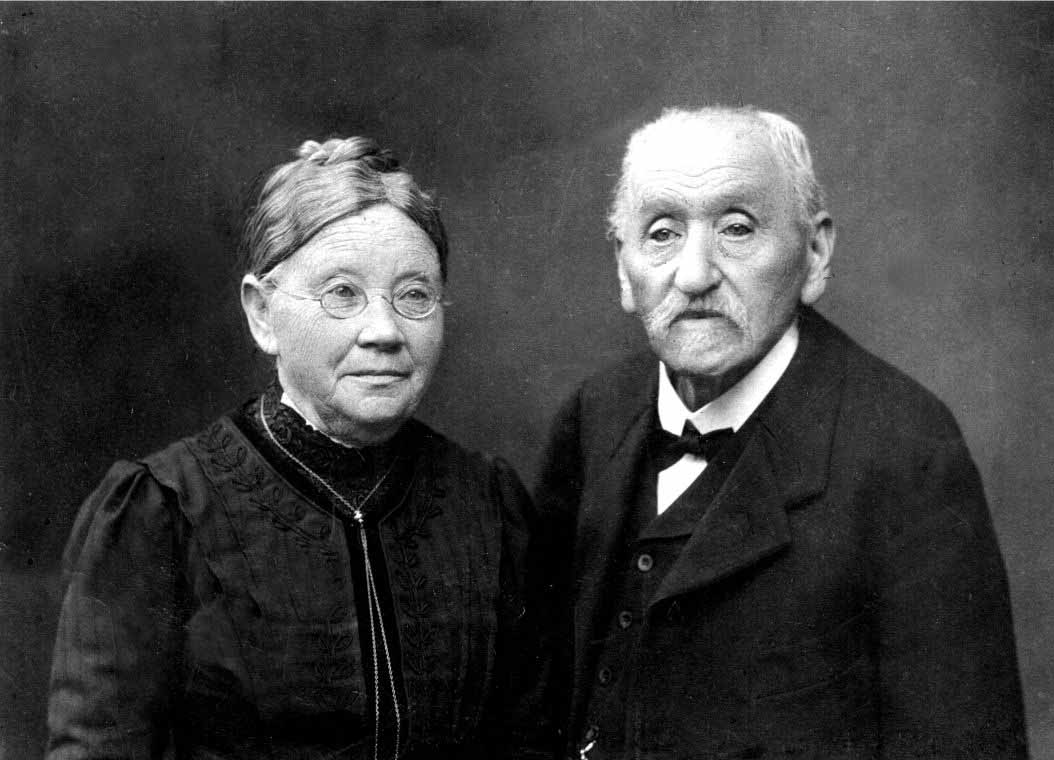
Isidor Adler and Frieda Adler at around 1912
(Taken from the archive of Ernst Schäll)
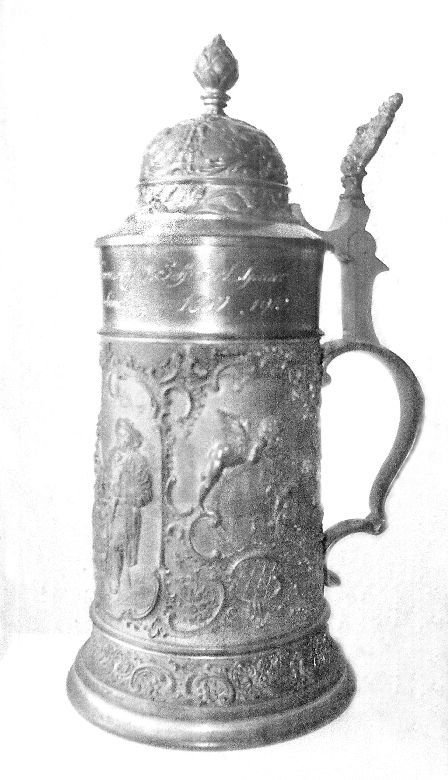
The Isidor Adler Company
gave this pewter jug to the wholesale grocer and baker Anton Schniertshauer
from Huettisheim as a gift in 1910. It bears the following inscription:
‘From the house of Isidor Adler to Mr. Anton Schniertshauer to commemorate 50 years of business relations from 1860-1910’
Only the forced aryanization of Jewish businesses in 1938/39 put a sudden
end to the business relations between the Isidor Adler Company and the
Schniertshauer grocery store (‘Fideles’). The following anecdote, which was
handed down from generation to generation and is verified by a newspaper
article, serves as proof of their excellent long lasting relations.
In 1868, the not so prosperous family of Anton Schniertshauer came to sudden
unexpected wealth when one of his sisters won the main prize in the Ulmer
Muensterbaulotterie, a lottery to
finance the restoration of the minster in the city of Ulm. But nobody in the
family dared to carry such a large sum of money from Ulm to Huettisheim, not
even Fidel. Thus, Isidor Adler had to come along all the way from Laupheim
to Ulm to fetch the 10,000 guilders, the German currency at that time.
The bakers’ and confectioners’ craft marked only the beginning of the company’s history, although today not many reliable records can be found. Even Isidor Adler was trained as a baker, but managed to rise to wholesale grocer very quickly. In 1859 he married his first wife in Augsburg and one can assume that he took over the family business in Laupheim at the same time. At that time the business was located across the street next to the Steiners’ family home. Since at least the 1860’s, Isidor Adler supplied the grocery shops in the smaller villages around Laupheim with sugar, salt, coffee, wine, vinegar and oil, even adding colonial goods to his inventory later on. Soon his business relations exceeded his district. During the arrival of a large delivery, for example a whole wagon full of special flour for calves, he would sell to the consumers directly at the station.
The main office as well as the family’s residence was located in the same
building on 44 Kapellen Street, together with a wholesale food store, which
was quite spacious for that time. The other rooms on the ground floor were
used as offices, where at times not only the owners of the company, but also
up to three employees used to work. Behind the building, storerooms,
stables, garages, a coffee roaster and a wine bottler could be found.
Warehouse workers, coachmen and drivers worked there, so that in times of
prosperity as many as ten people were employed by the company. This still
did not include the maids working in the household, of which Isidor Adler’s
family always had three. Even before World War I the company bought their
first truck to serve their customers in a better and faster way. The
family’s telephone number was ‘4’, which shows that they were not shy about
investing in new technologies.
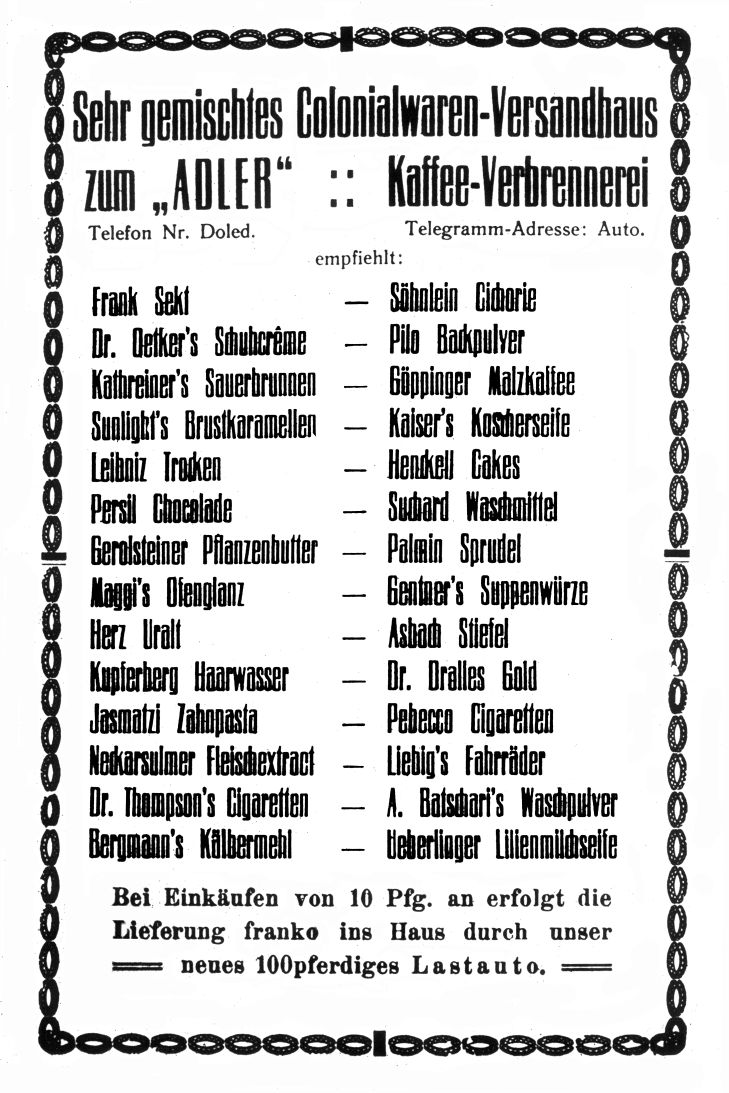
For Purim, the Gesangsverein
(choir) ‘Frohsinn’ organized at
least one ball per year, a social event with an extensive program, sometimes
even including a printed pamphlet with all kinds of funny commentaries. An
advert by the Isidor Adler Company can be found in one of those pamphlets
from 1912 on page 20 on the left side, giving a good impression of the wide
variety of products sold by the company: the days of the confectionery had
long been left behind. Although the unknown authors of the adverts changed
over time, it is remarkable to see that about half of the brands mentioned
in these pamphlets can still be purchased a hundred years later. The other
adverts (see below and on the following pages) were all taken from
Laupheim’s former local paper, ‘Laupheimer
Verkuendiger’. Such adverts are nearly the only traces left today that
provide information about the Isidor Adler Company.
Hardly anything is known about the economic impact the Nazi era had on the
Isidor Adler Company except that the former authorized signatory, Gebhard
Schneider, took over in 1939 and ran the company under his name. The same
can be said about the post-war situation, because, unlike as was the case
with other families and companies, there are no documents concerning
negotiations of restitution and compensation in the National Archive of the
city of Sigmaringen. All the remaining information from the time of the Nazi
era deals mainly with family matters and will be displayed in the following
paragraphs.
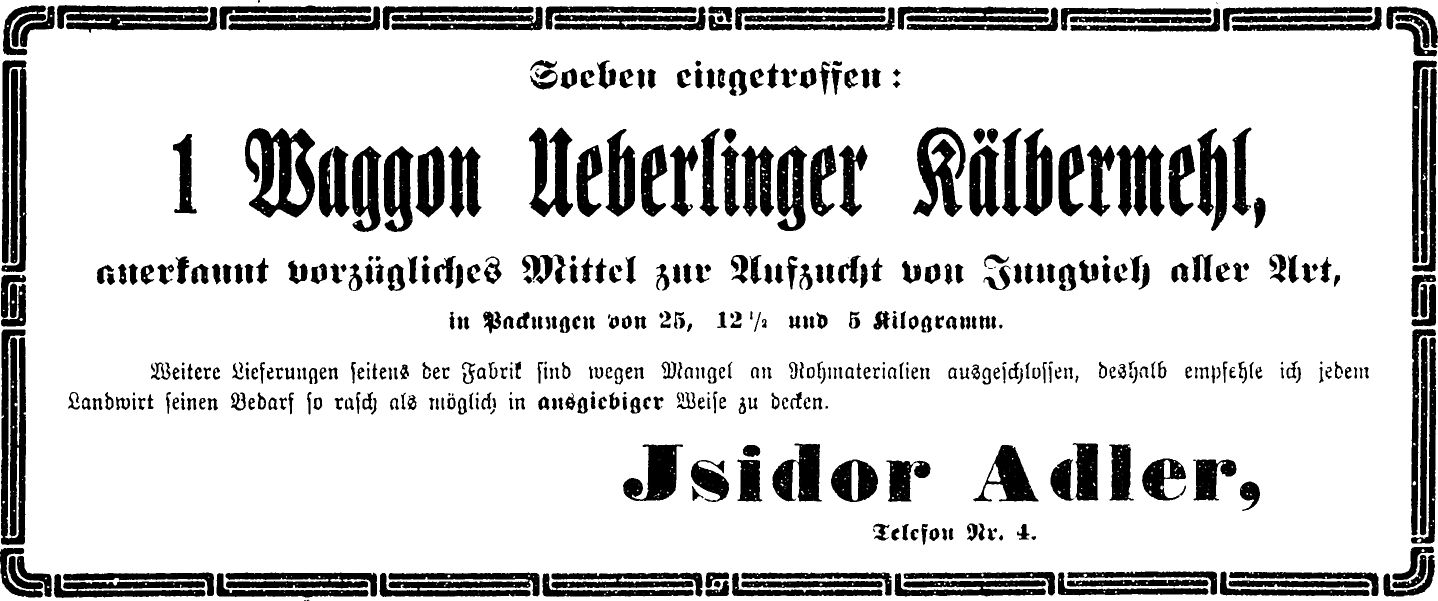
A scaled down advert
taken from the local paper ‘Laupheimer Verkuendiger’ is supposed to tell the
customers: Times are bad. Stock up now! The outbreak of World War I seven
months earlier led to the ‘lack of raw materials’ mentioned in the advert
and made further deliveries of special flour for calves impossible. The
advert from March 13, 1915 shows clearly how quickly Germany was running out
of raw materials and food due to the war.
The oldest of the adverts
down below dates back to January 31, 1874. In the ‘Laupheimer Verkuendiger’,
Isidor Adler advertises his flour prices and recommends flour No. 2. At that
time, guilders and kreutzer were still the common currency in Germany (fl =
guilder, one guilder consisted of 60 kreutzer). The changeover to the new
national currency, the Reichsmark, took place a few years after the
foundation of the German Reich in 1871. The Reichsmark was introduced in the
state of Wuerttemberg on July 1, 1875. One guilder was 1.75
Reichsmark.
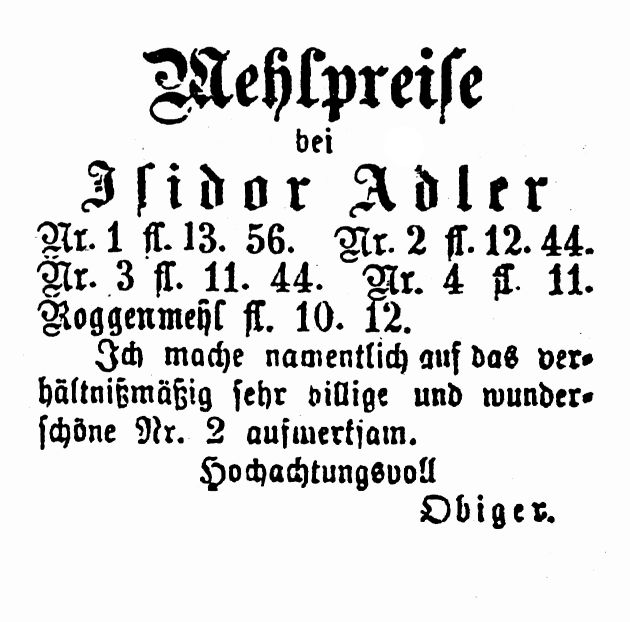
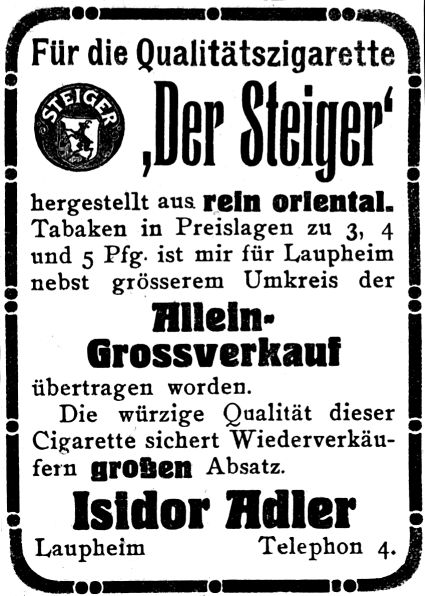 |
|
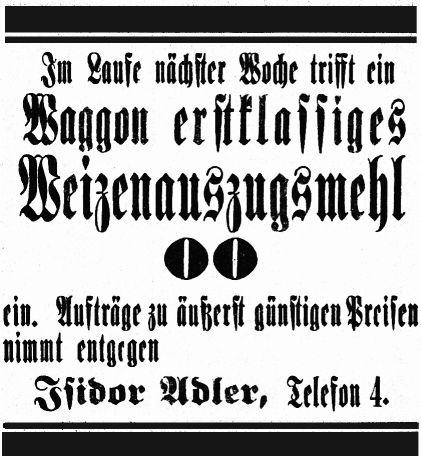
 |
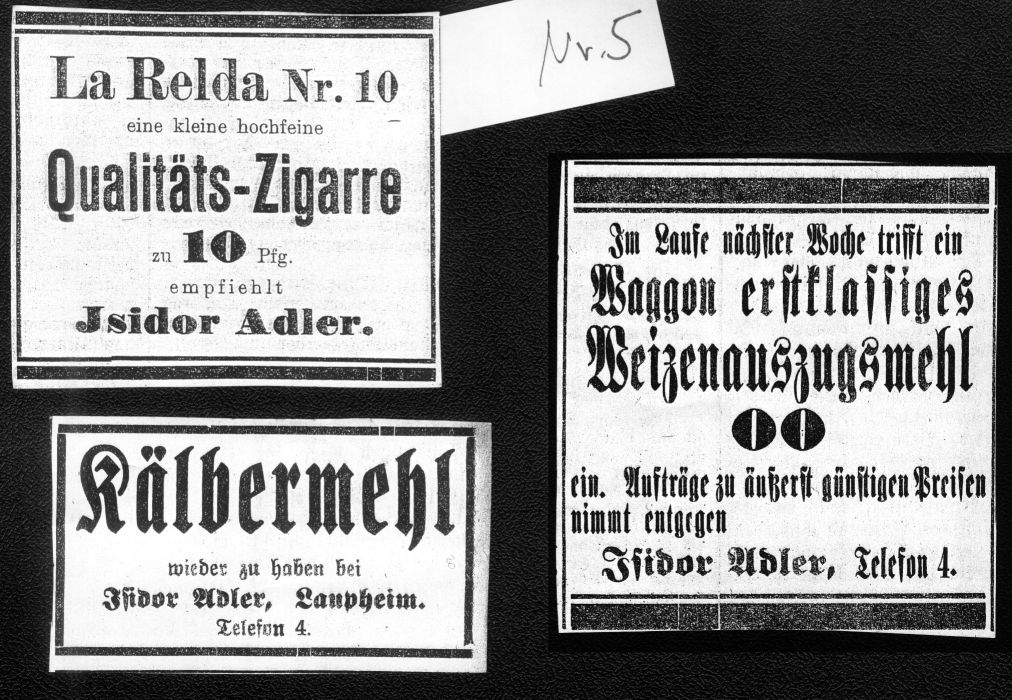
The ‘high holidays’ in
autumn start with the traditional Jewish new year festivities of Rosh
Hashanah, which fall on a different date each year. Rosh Hashanah is then
followed by the most important Jewish holiday, Yom Kippur; after that,
Sukkoth is celebrated. The high holidays come to an end with the celebration
of Simchat Torah. Should New Year and Yom Kippur fall on a workday, Jewish
shops would remain closed, as was the case in 1903 and 1924.
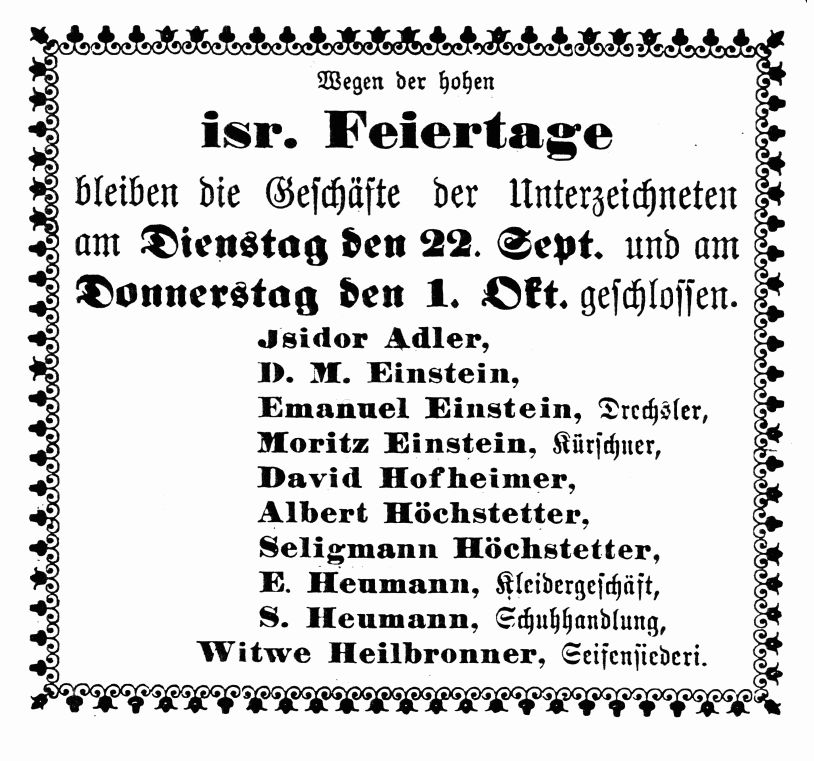
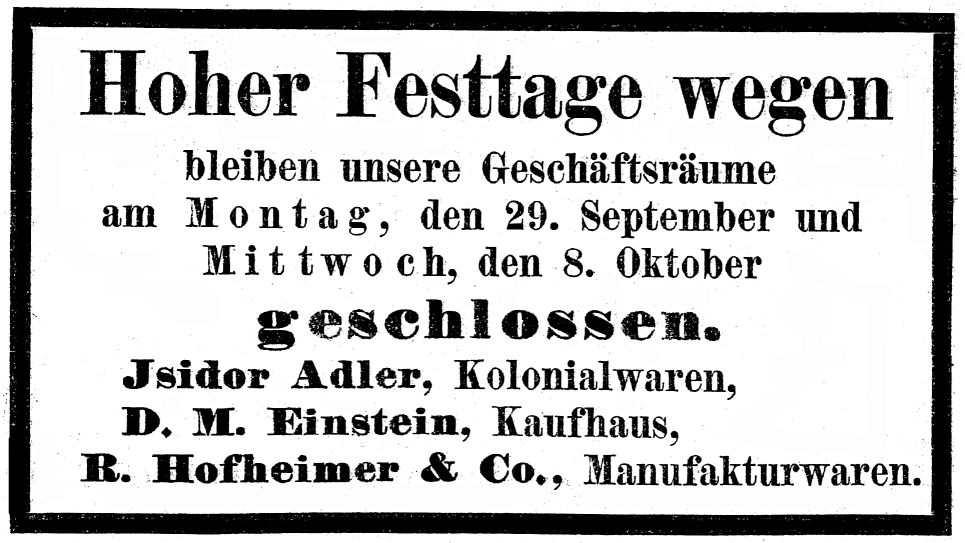
Some of the companies who
had put their adverts in the ‘Laupheimer Verkuendiger’ in 1903 did not exist
anymore in 1924, such as a tailor’s shop called Hoechstetter, or Einstein, a
turner’s workshop. Other companies chose not to close their shops on the
special holidays mentioned above.

